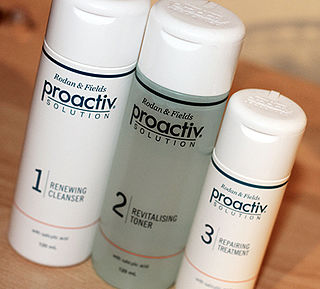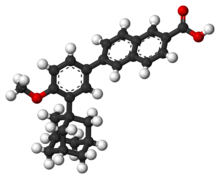
Acne, also known as acne vulgaris, is a long-term skin condition that occurs when dead skin cells and oil from the skin clog hair follicles. Typical features of the condition include blackheads or whiteheads, pimples, oily skin, and possible scarring. It primarily affects skin with a relatively high number of oil glands, including the face, upper part of the chest, and back. The resulting appearance can lead to lack of confidence, anxiety, reduced self-esteem, and, in extreme cases, depression or thoughts of suicide.

Isotretinoin, also known as 13-cis-retinoic acid and sold under the brand name Accutane among others, is a medication primarily used to treat severe acne. It is also used to prevent certain skin cancers, and in the treatment of other cancers. It is used to treat harlequin-type ichthyosis, a usually lethal skin disease, and lamellar ichthyosis. It is a retinoid, meaning it is related to vitamin A, and is found in small quantities naturally in the body. Its isomer, tretinoin, is also an acne drug.

Clindamycin is a lincosamide antibiotic medication used for the treatment of a number of bacterial infections, including osteomyelitis (bone) or joint infections, pelvic inflammatory disease, strep throat, pneumonia, acute otitis media, and endocarditis. It can also be used to treat acne, and some cases of methicillin-resistant Staphylococcus aureus (MRSA). In combination with quinine, it can be used to treat malaria. It is available by mouth, by injection into a vein, and as a cream or a gel to be applied to the skin or in the vagina.

Tretinoin, also known as all-trans retinoic acid (ATRA), is a medication used for the treatment of acne and acute promyelocytic leukemia. For acne, it is applied to the skin as a cream, gel or ointment. For leukemia, it is taken by mouth for up to three months. Topical tretinoin is also the most extensively investigated retinoid therapy for photoaging.
ATC code D10Anti-acne preparations is a therapeutic subgroup of the Anatomical Therapeutic Chemical Classification System, a system of alphanumeric codes developed by the World Health Organization (WHO) for the classification of drugs and other medical products. Subgroup D10 is part of the anatomical group D Dermatologicals.

Benzoyl peroxide is a chemical compound (specifically, an organic peroxide) with structural formula (C6H5−C(=O)O−)2, often abbreviated as (BzO)2. In terms of its structure, the molecule can be described as two benzoyl (C6H5−C(=O)−, Bz) groups connected by a peroxide (−O−O−). It is a white granular solid with a faint odour of benzaldehyde, poorly soluble in water but soluble in acetone, ethanol, and many other organic solvents. Benzoyl peroxide is an oxidizer, which is principally used as in the production of polymers.

The retinoids are a class of chemical compounds that are vitamers of vitamin A or are chemically related to it. Retinoids have found use in medicine where they regulate epithelial cell growth.

Tazarotene, sold under the brand name Tazorac, among others, is a third-generation prescription topical retinoid. It is primarily used for the treatment of plaque psoriasis and acne. Tazarotene is also used as a therapeutic for photoaged and photodamaged skin. It is a member of the acetylenic class of retinoids.

Proactiv is an American brand of skin-care products developed by two American dermatologists, Katie Rodan and Kathy A. Fields, and launched in 1995 by Guthy-Renker, a California-based direct marketing company, that was endorsed by famous celebrities The range includes moisturizers, body washes and treatment products, but the brand is known for its three-step anti-acne Solutions 3-step routine consisting of a BPO cleanser, glycolic toner and treatment lotion. Proactiv+, a reformulation of the three-step kit, was introduced in 2013, and in 2017, ProactivMD launches powered by Adapalene.

Azelaic acid (AzA) is an organic compound with the formula HOOC(CH2)7COOH. This saturated dicarboxylic acid exists as a white powder. It is found in wheat, rye, and barley. It is a precursor to diverse industrial products including polymers and plasticizers, as well as being a component of a number of hair and skin conditioners. AzA inhibits tyrosinase.

Clindamycin/benzoyl peroxide is a topical gel used for the treatment of acne. It is a fixed-dose combination of clindamycin, as the phosphate, an antibiotic, and benzoyl peroxide, an antiseptic.

Nadifloxacin is a topical fluoroquinolone antibiotic for the treatment of acne vulgaris. It is also used to treat bacterial skin infections.
Clindamycin/tretinoin is a topical gel used in the treatment of acne. The two active ingredients are the antibiotic clindamycin phosphate (1.2%) and tretinoin (0.025%), a retinoid. The two active ingredients perform different functions, the clindamycin is active against gram-positive bacteria, including streptococci and penicillin-resistant staphylococci. The Tretinoin element acts to reduce the amount of oil released by oil glands in skin, as well as encouraging skin cell replenishment. The topical treatment is stored in 2, 30, and 60 gram tubes and should be stored at 25°C (77°F), with the tube tightly shut away from light. Side effects may include peeling, redness, dryness, itching and photosensitivity. Also, topical clindamycin may rarely cause diarrhea or colitis. Sun exposure while using this preparation can cause skin irritation.

Neonatal acne, also known as acne neonatorum, is a type of acne that develops in newborns, typically before 6 weeks of life. It presents with open and closed comedones on the cheeks, chin and forehead.

A pimple or zit is a kind of comedo that results from excess sebum and dead skin cells getting trapped in the pores of the skin. In its aggravated state, it may evolve into a pustule or papule. Pimples can be treated by acne medications, antibiotics, and anti-inflammatories prescribed by a physician, or various over the counter remedies purchased at a pharmacy.

Photoaging or photoageing is a term used for the characteristic changes to skin induced by chronic UVA and UVB exposure. Tretinoin is the best studied retinoid in the treatment of photoaging.

Adapalene/benzoyl peroxide, sold under the brand name Epiduo among others, is a fixed-dose combination medication for the treatment of severe acne vulgaris. It consists of a combination of adapalene and benzoyl peroxide in a topical gel formulation.
Infantile acne is a form of acne that begins in very young children. Typical symptoms include inflammatory and noninflammatory lesions, papules and pustules most commonly present on the face. No cause of infantile acne has been established but it may be caused by increased sebaceous gland secretions due to elevated androgens, genetics and the fetal adrenal gland causing increased sebum production. Infantile acne can resolve by itself by age 1 or 2. However, treatment options include topical benzyl peroxide, topical retinoids and topical antibiotics in most cases.
Tretinoin/benzoyl peroxide, sold under the brand name Twyneo, is a fixed-dose combination medication used for the treatment of acne. It contains tretinoin, a vitamin A derivative, and benzoyl peroxide, an oxidizing agent.
Clindamycin/adapalene/benzoyl peroxide, sold under the brand name Cabtreo, is a fixed-dose combination medication used for the treatment of acne. It contains clindamycin, as the phosphate, a lincosamide antibacterial; adapalene, a synthetic retinoid; and benzoyl peroxide, an oxidizing agent. It is applied to the skin.















